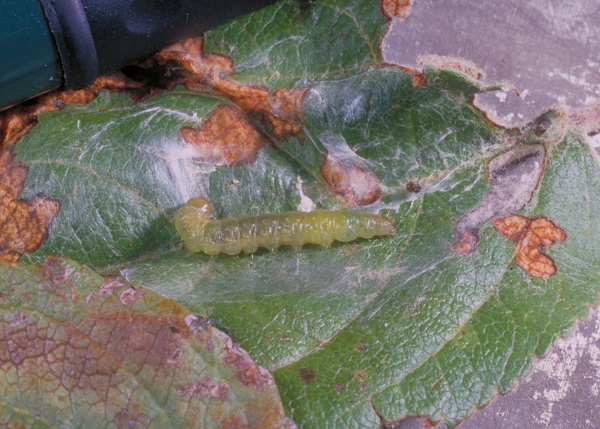Leafrollers
ENTFACT-216: Leafhoppers | Download PDF
by Ric Bessin, Extension Specialist
University of Kentucky College of Agriculture
In Kentucky, three leafroller species, redbanded leafroller (Argyrotaenia velutinana), obliquebanded leafroller (Choristoneura rosaceana), and fruittree leafroller (Archips argyrospila), commonly attack fruit trees as well as some landscape ornamentals. While many types of plants are attacked, the redbanded leafroller has a strong preference for apples. Redbanded leafroller larvae feed on apple foliage and often feed on fruit, with the last generation of the season doing the most serious damage. The larvae of each species can damage the fruit when they attach a leaf to the fruit surface and then feed on skin and flesh.

Figure 1. Leafroller larva and damage.
Description
The obliquebanded leafroller is brown with three dark bands on the front wings. Wingspread is about one inch. Larva are small and green with black heads. The redbanded leafroller is brown, about the size of the codling moth, and have broad reddish bands on each forewing. Larva are green, slender and will reach a length of about 2/3 inch. The fruittree leafroller is a brown moth slightly larger than the codling moth. Thin light markings will appear in various patterns across the front wings. The larva is a slender worm, pale green in color. The head is black and a black spot will appear just behind the head. The larva may reach 3/4 inch in length.
Biology
The redbanded leafroller overwinters as a pupa in debris on the ground. Adults emerge in early spring and lay eggs in masses on undersides of larger limbs. Egg hatch occurs at about bloom. Newly hatched larvae fold or roll leaves together with webbing and feed on foliage. There are two to four generations each year.
The fruittree leafroller overwinters in the egg stage. Hatching will occur about the time buds begin to open. Larvae feed on buds, blooms, leaves and fruits. In June, full grown larva transform into pupae, inside folded or rolled up leaves. Moths appear in about two weeks, lay their eggs, and die. Only one generation occurs each year.
Overwintering of the obliquebanded leafroller occurs as partially grown larva inside tightly woven cases, on the host trees. During spring, larva emerge and resume feeding until late May. Pupation occurs and adults will emerge in June. One or two generations may occur each year. Damage is done by young larva mining the leaves, with larger larva feeding inside rolled up leaves or leaves attached to fruits.
Management
Leafroller populations can be sampled by both tree examination and pheromone trap. Because these have wide host ranges, pheromone trap catch numbers are of limited value in determining economic thresholds and the need to spray. Pheromone trap catches will indicate when to monitor carefully for the larvae. Pheromone traps should be in place by the pink stage and maintained through September. Monitor for larvae by examining the number of larvae per 100 leaves or fruit clusters. Use an average of 4 larvae per 100 leaves or fruit clusters for making management decisions.
In commercial orchards in Kentucky, cover sprays for codling moth and other orchard pests control leafrollers as well. Egg hatch with the redbanded leafroller often coincides with petal fall, so sprays applied at this time should be used for control. In some eastern states of the United States, the obliquebanded leafroller has become resistant to organophosphate insecticides, so chemicals with different modes of action may be required in those areas.
With backyard apple plantings, leafrollers can be controlled as necessary with sprays containing Bacillus thuringiensis (Bt). Sprays are most effective when applied while the larvae are small, before they begin to web leaves together.
Revised: 11/19
CAUTION! Pesticide recommendations in this publication are registered for use in Kentucky, USA ONLY! The use of some products may not be legal in your state or country. Please check with your local county agent or regulatory official before using any pesticide mentioned in this publication.
Of course, ALWAYS READ AND FOLLOW LABEL DIRECTIONS FOR SAFE USE OF ANY PESTICIDE!
Photos courtesy Ric Bessin, University of Kentucky Entomology
